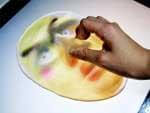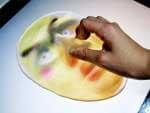PhotoelasticTouch Combines 3D Shapes With Touchscreens

Share

The average touchscreen leaves you petting or clawing at a flat surface, but the new PhotoelasticTouch system gives you something to squeeze. Produced by researchers at the University of Electro-communications and the Japan Science & Technology Agency, the photo-elastic system uses transparent rubber shapes that sit on a LCD screen to act as input devices. Touch a 3D face and the screen changes the eyes so look at what you're doing. Pick up a rubber shape and twist it to pour virtual paint onto the surface. The developers presented their innovation at SIGGRAPH earlier this year and let attendees play with the new interface. It's a pretty awesome concept and you can check it out in the videos from TheKeyIdea blog after the break.
I'm not sure if squeezably soft 3D rubber screen-toppers count as haptics devices, but there's certainly something rewarding about having any sort of tactile interaction with a computer. As we enter into the next generation of human-computer interfaces, we're going to see a lot more emphasis on physicality. Humans, after all, are often tactile/kinetic learners.
As the video above explains, the light from the LCD is polarized. A camera above the screen also has a polarized filter. When the transparent rubber object between the two is deformed, it changes the polarization of the LCD light. The camera detects this change and voila, the system responds to the deformation. Not only can this PhotoelasticTouch concept be used to animate the 3D objects, it also serves as a mouse tool with variable pressure response. Check out the video below to see what I mean:
Be Part of the Future
Sign up to receive top stories about groundbreaking technologies and visionary thinkers from SingularityHub.


What happens when you cover the entire screen with transparent rubber? You get a tactile surface that easily responds to position and pressure. The rubber is an overlay rather than built-in presumably because the team worked with an off-the-shelf LCD touchscreen. I would think that eventually the system should just incorporate the rubber surface into the touchscreen. In any case, multiple layers of the transparent material can be stacked without noticeable loss of signal from the LCD screen as shown in this video:
I've noticed that these next generation interface prototypes always have a simple art software package associated with them. While I applaud the combination of art and technology, I wonder if the developers for these technologies have done any long term thinking about the software innovations that will have to accompany their hardware upgrades. What sort of programs will require a squeezable rubber interface? As cool as the PhotoelasticTouch system may be, is it that much better than a traditional touchscreen?
To some degree, I feel like a majority of the human-computer interface research I see is still in the "see what sticks to the wall" phase. Innovators seem to be trying out any crazy idea that may work. I love it. We're going to get many junk ideas from that approach, but we'll also get a more thorough exploration of the possible ideas. I'm not sure the transparent rubber interface is useful enough to become a dominant trend in touchscreen technology, but it definitely looks cool. For the next few years that's likely to be something I say often as we continue to watch how human-computer interfaces develop. Eventually though, we may find a system that is so intuitive, precise, and easy to learn that keyboards and mice will vanish in its wake. Hopefully that system will be as fun to use as PhotoelasticTouch.
[photo credit: University of Electrocommunication, Jappan Science &Technology Agency]
[video credit: Billy Chen, TheKeyIdea]
Related Articles

This Light-Powered AI Chip Is 100x Faster Than a Top Nvidia GPU

How Scientists Are Growing Computers From Human Brain Cells—and Why They Want to Keep Doing It

These Brain Implants Are Smaller Than Cells and Can Be Injected Into Veins
What we’re reading